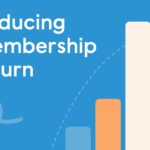Having a database of info you can easily find and use is only the first step. Having data, feeling comfortable poking around it and knowing how to use it are all different things. In this article, we’re talking about the last two; How to empower your staff — and you! — to feel comfortable using member data and what you can actually do to get started on data-driven decision making.

Helping your staff get cozy with your member data
A database can be daunting if it’s new or freshly cleaned up and organized. But just like nice dinnerware or a fancy sports car, it’s really not worth having unless you use it.
You may not want all your staff in your database, but it’s a good idea to educate everyone on the power of data. Even if they aren’t in it now, they may be one day. Plus, it’s helpful for everyone to know what you mean when you bring up data in other contexts.
Here are a few ways to help your staff get cozy with data.
Explain the “why”, “where” and “how”
These points are often jumped over because the numbers are so exciting. When you kickstart your education with your staff, answer:
- Why you collect data
- Where it comes from
- How you use it (and want to use it in the future)
These three points lay a foundation of understanding that builds a lot of context around the numbers.
These points help to drive home the importance of following processes and using the same procedures for data collection; your system needs to be coherent because there’s a bigger picture. So, any future data collection needs to be done with this in mind.
Encourage your staff to poke around.
Show and tell can only go so far for data. Give your staff the freedom to play around with your software in their own time. Encourage them to look for trends and to bring forward any learnings, observations or questions.
If we can drive home one thing it would be that data is only good if it’s used. While we understand wanting to keep data under lock and key to preserve it, it is also there to be used. So let your staff poke around. You may uncover something you didn’t know about your members before.
Lean on your database provider.
Every person who joins your association staff should attend introductory database training shortly after they start. This will help them understand the importance of your system early on while giving them some basic understanding of how to use it. From there, you can teach them how your team prefers to use certain features and your processes.
And ask if your database provider has a library of instructional resources. If not, it’s worth starting to build one of your own.
4 actions to take to put your data to use
Whether you’ve just finished a database clean up or are really diving into member data for the first time, the next step is the fun part: looking at data and using it to take action to improve your association or chamber. How can you use it to your best advantage?
Here are some great ways to start making the most of your database:
1. Engage members who are slowly “dropping off”
Your database likely lets you see how engaged your members really are: who’s opening your emails, who’s attending your events, who’s volunteering, etc.
Or better yet, who’s not.
Could you use that information to create a special campaign for unengaged members? Absolutely! You could send them a coupon for a discount on your next webinar or have a staff member/board member/volunteer give them a call. Use that information to re-engage those members before it’s too late.
2. Convert prospects into members
You likely spend some time marketing to prospective members, but how are you actually nurturing them so that they become members?
For example, let’s say you had an event and several prospects registered AND attended. Could you pull a list from your database and create an email marketing campaign for those prospect attendees? Could you let them know that you hope the event was valuable and that if they want even more value, they should consider joining (and then go on to list your association’s benefits)? It’s definitely worth a shot!
3. Identify your most engaged members (and convert them into member ambassadors)
As we’ve mentioned, your database allows you to see how engaged your members really are. But what’s great about that is you can then identify your most engaged members and then (hopefully) convert them into member ambassadors — champions of your organization.
Take a look at who’s attending your events, who’s opening your emails, who’s volunteering, who’s reading your blog. Then reach out to those members with some kind of incentive. See if they’d be willing to help promote your event for a discount on registration. Or if they’d be willing to volunteer for a VIP upgrade.
4. Set up some rules to avoid messy data in the future
By revisiting and revising your current processes, this step should take care of itself. When you’re reviewing your processes, make sure to add in opportunities to regularly address, share, and clean your data.
Add a special agenda item on a monthly staff meeting to allow the database project champion to bring up any questions or concerns about the database. Include an internal audit of the database every year into your project calendars. Encourage people running data reports to always use an extra set of eyes before distributing any reports widely.
Association data: There to be used
Data can feel intimidating because there’s so much behind it. But once you start getting into it, it can be a lot of fun! There’s so much to learn from renewal rates, engagement actions, email opens and everything else you collect about your members. Data can help you plan more successful events, communicate effectively with your members and spend your budget wiser. So get in there! And have fun!
















